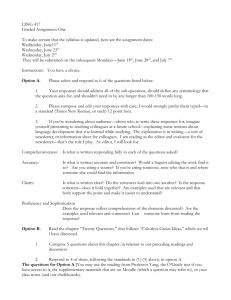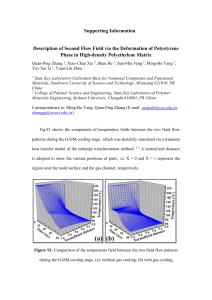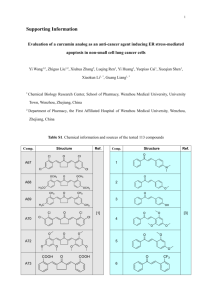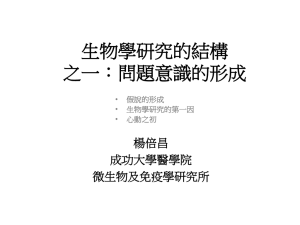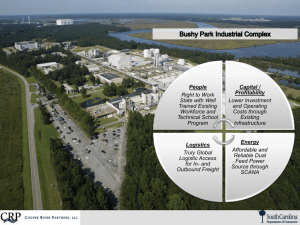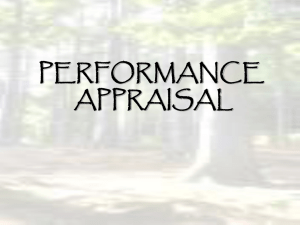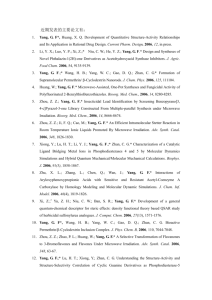Dr. Matthew Xu-Friedman - Department of Biological Sciences
advertisement
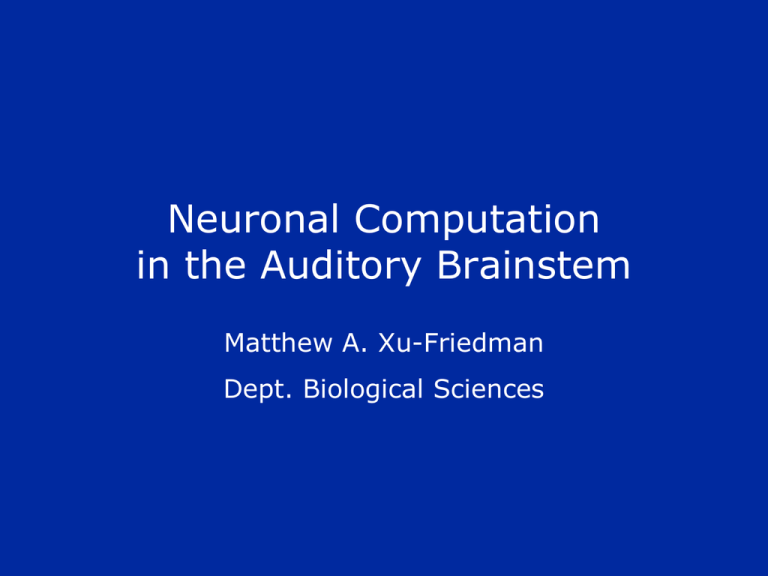
Neuronal Computation in the Auditory Brainstem Matthew A. Xu-Friedman Dept. Biological Sciences Synaptic Transmission Ca2+ EPSP + action potential EPSC • How is synaptic transmission affected by activity? • Mechanism • Functional consequences Mammalian Auditory System • • • • Analyzes and localizes sounds Requires precise temporal information Uses precise timing of spikes Preserves and improves temporal information with various adaptations • We focus on the synapse formed by auditory nerve fibers onto bushy cells in the cochlear nucleus • Endbulb of Held Bushy cell Experimental Setup Slice Recording Stimulate Record Current Projects • How does ongoing activity affect synapses? • How does auditory experience influence development? • How are action potentials initiated with precision? Effects of Activity 100 Hz 20 ms 200 2 nA 10 ms 333 6 ms • Depression results from: • Vesicle depletion & receptor desensitization • (Yang & X-F, 2008; Chanda & X-F, 2010) • Consequence • Bushy cells respond less reliably after a while • What about more realistic conditions? Voltage clamp P15–21 mice 34°C Synaptic Variance * * Hua Yang * 1 nA 0.1 s • Synaptic transmission has both stochastic (random) and deterministic (predictable) components • How does randomness affect transmission of information? • Is it disruptive? 50 Hz Poisson Effects of Randomness Conductance (nS) • Mimic random and nonrandom synaptic input, by injecting current into the cell • With non-random synapse, spiking is very consistent, but some EPSPs consistently fail • With random synapse, even small EPSPs can sometimes cause spike • Randomness enhances information transmission 150 0 0 20 Pulse number 40 mV 40 100 Hz 50 ms Yang & X-F (in press) Auditory Experience Tenzin Ngodup Normal Noise-reared * EPSC2/EPSC1 Dt Xiaowen Zhuang 2 nA 10 ms 1 0 0.001 0.01 0.1 Dt (s) • How is the degree of depression set? • Does it depend on the animal’s experience? • Rear animals in noise & assess changes • Reduces depression, and can cause facilitation • Starting to look at opposite treatment (ear-plugging) • Increases depression • Adaptive, homeostatic response? • How are responses to real sounds affected? 1 Action Potential Initiation Yang Yang Vm (mV) Typical Neuron dendrites 0 –60 dVm/dt (V/ms) 0.5 s 20 ms 0.5 ms 0.2 0.5 ms soma 0 –0.2 –60 0 Vm (mV) • • • • • Bushy cell axon –60 0 Vm (mV) Why do bushy cells have very small action potentials? Most neurons have two pools of sodium channels Bushy cells only have one Does this adaptation support precise timing? Developing new electrophysiology tools to study Acknowledgements Jack Goetz Tenzin Ngodup Hua Yang Xiaowen Zhuang Former Lab Members Soham Chanda, PhD’10 (postdoc, Stanford) Alexander Fischer (grad student, TU Kaiserslautern) Tim Jarsky (Scientist II, Allen Institute) Lioudmila Pliss (NP, private practice) Sangrok Oh, MS’09 (DO, UB SMBS) John Trimper (grad student, Emory) Collaborations Richard Salvi, Center for Hearing and Deafness Micheal Dent, Psychology Tobias Moser & Andreas Neef, Göttingen Funding NIDCD NSF IOS 1208131 Yang Yang

